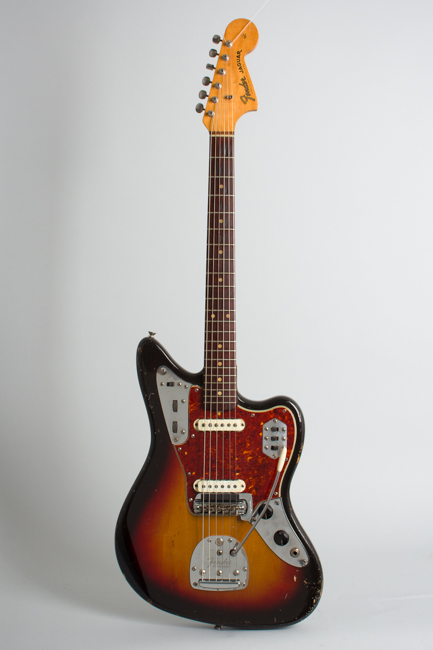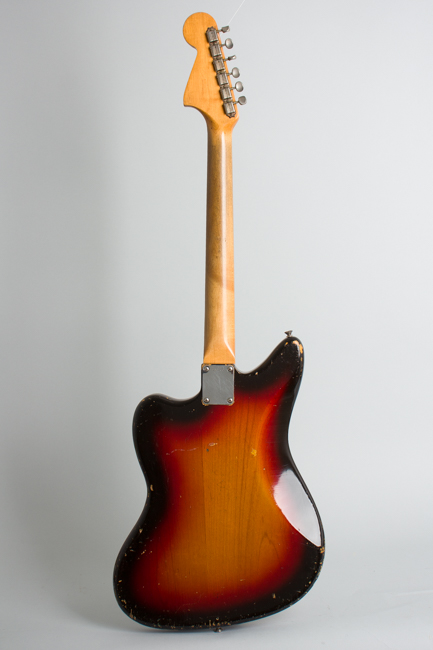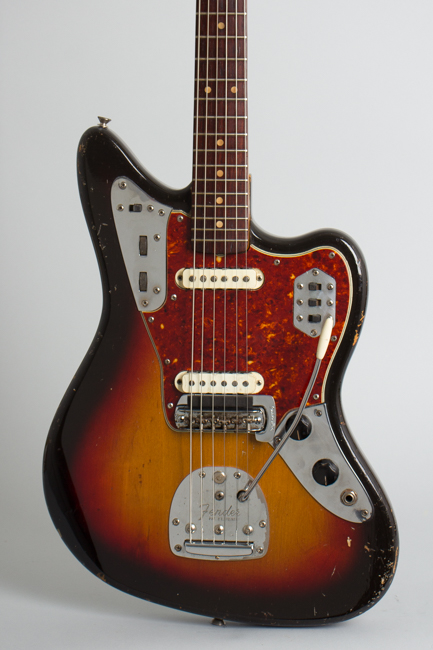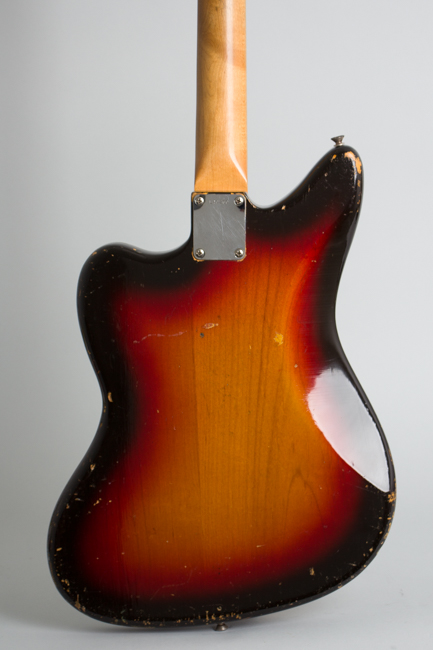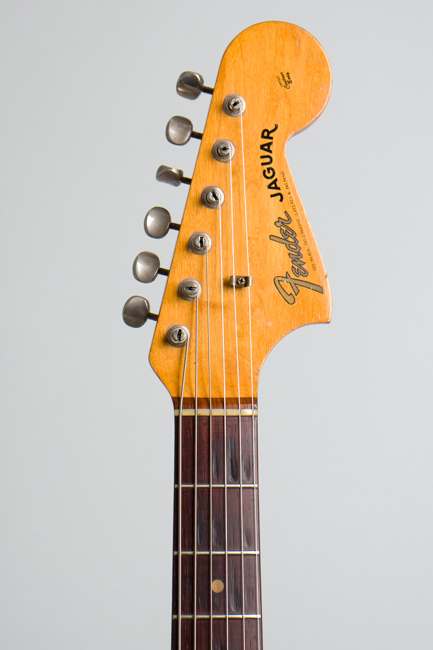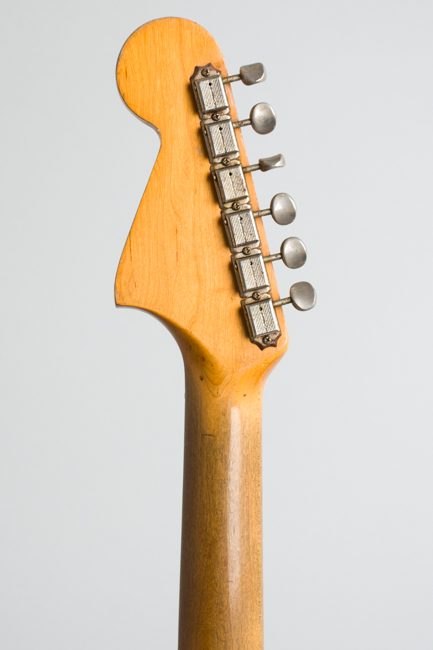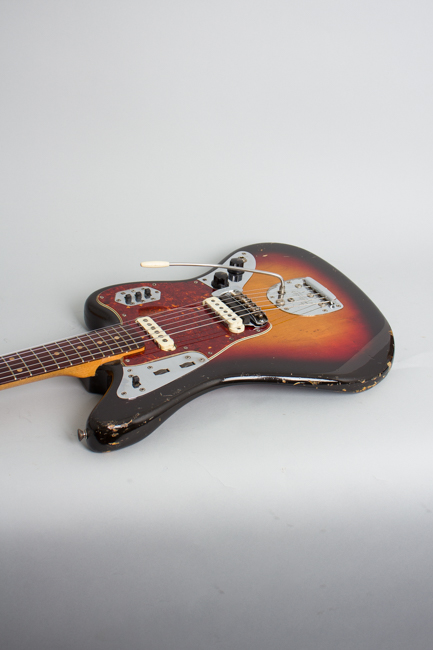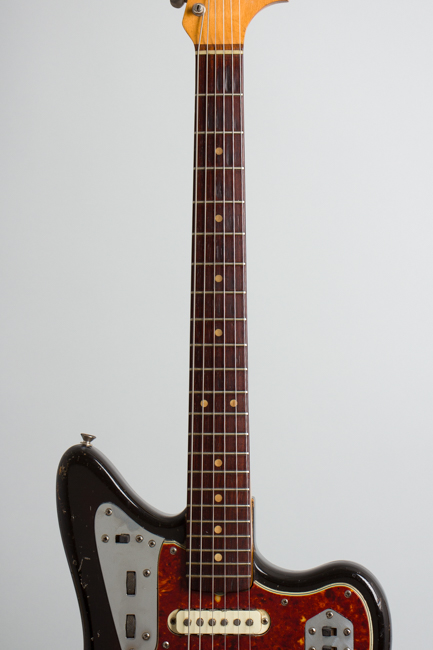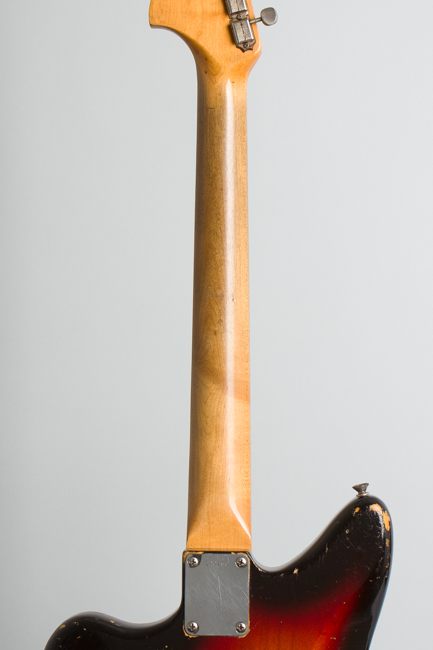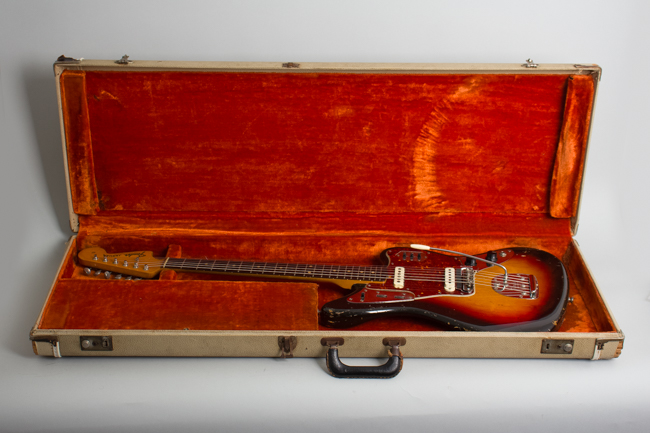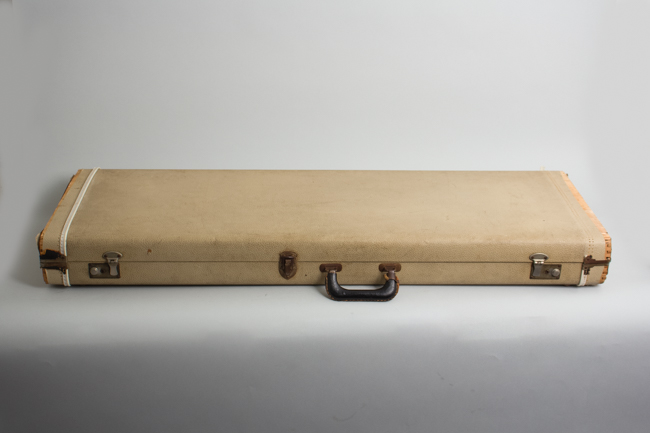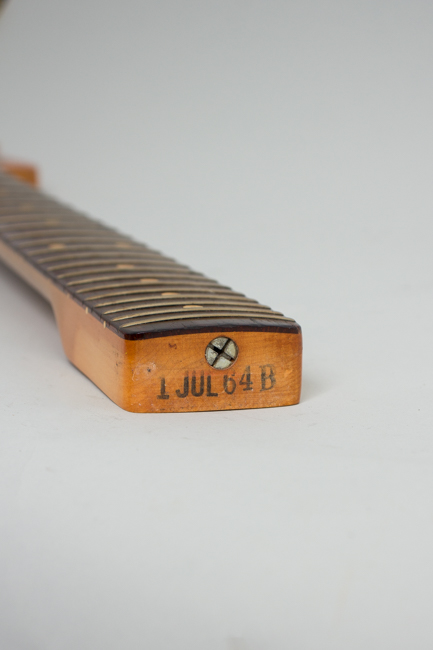Fender Jaguar Solid Body Electric Guitar (1964)
Fender Jaguar Model Solid Body Electric Guitar (1964), made in Fullerton, California, serial # L40260, sunburst lacquer finish, alder body, maple neck with rosewood fingerboard, original blond tolex hard shell case.
This veteran third-year Fender Jaguar shows wear and tear from decades of play but offers a super vibey feel and a world of classic twang. The Jaguar debuted in spring 1962 as Fender's new top-of-the line guitar, supplanting the Jazzmaster. The shorter scale and flashy chrome-accented look quickly made it a status symbol for many combos in the early '60s, not only California teen bands but also country players and even many Chitlin' Circuit R&B acts.
This Jaguar has a neck dated July 1964, the "high summer" at Fender before CBS bought in and a bit over two years after the first ones rolled off the line. The larger pots are coded to the 8th week of that year. Typical '64 features include an unbound rosewood fingerboard with clay dot inlay, a very deep blended 3-color sunburst and gold "transition" Fender logo decal. The floating bridge, trem system and upper-bout rhythm circuit carried on from the Jazzmaster, with pickup selection now controlled by a bank of slide switches on the treble side. Each pickup has an on/off switch, while the third is a "strangle" switch that cuts lower frequencies. This all combines to make the "Jag" a flexible guitar with a lot of sonic options.
The Jaguar's scale length at 24" is shorter than the other pro-grade Fender guitars, the same as the student-oriented Mustang, Musicmaster and Duo-Sonic. Combined with the Jazzmaster floating tremolo unit this means the guitar is very supple to play but performs better with heavier gauge strings. The two single-coil pickups have metal "claws" underneath the coil and are optimized for clarity, punch and crispness. This combination of factors caused the Jaguar to fall from popularity in the late '60s as twang went out and string-bending with heavy distortion and crunch came in!
Nevertheless these are still the top-of-the line '60s Fenders; quite popular when new and extremely high quality guitars. Despite a strong recent revival, the Jaguar remains a historically under-appreciated guitar. This is a well-played guitar, definitely someone's gigging instrument but still a great-playing and sounding Jag. We often find the earlier Pre-CBS Jaguars to be the pick of their litter and especially good instruments; this well-used one is no exception.
Overall length is 40 in. (101.6 cm.), 13 7/8 in. (35.2 cm.) wide at lower bout, and 1 5/8 in. (4.1 cm.) in depth, measured at side of rim. Scale length is 24 in. (610 mm.). Width of nut is 1 5/8 in. (41 mm.).
This is a well-played guitar, a true relic showing evidence of long use but remaining largely original. The only notable repair is the bridge pickup has been perfectly rewound to the original spec. so a few solder joints were redone.
While there is quite a bit of wear overall, the body finish does not have large areas flaking or lost down to the wood as is sometimes found on heavily-used Fenders. The dark sunburst is not much faded and there is only some lateral checking to the body. There IS a large collection of dings, chips and scrapes overall, especially to the body edges. There are deeper wear spots through the lacquer occasionally into the wood in numerous places, most heavily to the sides of the body especially on the lower bass bout. The only added finish is some touchup and a clear overspray to the upper body quarter armwear spot where there was a deep scrape a previous owner wanted to "fix up".
The back of the neck is heavily worn down to the bare wood over a decent part of its length and feels fantastic, with that classic "old Fender" vibe. The headstock finish is somewhat "smoked" with some dings and dents; the decal is fully intact. The frets appear original (or likely a very old exact-wire refret) and have been crowned down somewhat but remain fully playable showing some wear in the lower positions. The fingerboard has some divots but nothing that impedes play.
The chrome shows general wear overall but all hardware is complete and intact except the snap-on bridge cover which is long gone. The Trem arm remains original, as do all bridge components. The mute is installed but not functional. The plastic pickup covers have some wear and dings to the upper edges.
This Jag lives in the original blonde Tolex case, solid but heavily worn with the leather ends (and some Tolex) completely gone. All-in-all this is a great sounding early Jaguar, ragged but right, the sort of genuine relic you just can't create artificially, although folks are constantly trying these days. Overall Very Good + Condition.
This veteran third-year Fender Jaguar shows wear and tear from decades of play but offers a super vibey feel and a world of classic twang. The Jaguar debuted in spring 1962 as Fender's new top-of-the line guitar, supplanting the Jazzmaster. The shorter scale and flashy chrome-accented look quickly made it a status symbol for many combos in the early '60s, not only California teen bands but also country players and even many Chitlin' Circuit R&B acts.
This Jaguar has a neck dated July 1964, the "high summer" at Fender before CBS bought in and a bit over two years after the first ones rolled off the line. The larger pots are coded to the 8th week of that year. Typical '64 features include an unbound rosewood fingerboard with clay dot inlay, a very deep blended 3-color sunburst and gold "transition" Fender logo decal. The floating bridge, trem system and upper-bout rhythm circuit carried on from the Jazzmaster, with pickup selection now controlled by a bank of slide switches on the treble side. Each pickup has an on/off switch, while the third is a "strangle" switch that cuts lower frequencies. This all combines to make the "Jag" a flexible guitar with a lot of sonic options.
The Jaguar's scale length at 24" is shorter than the other pro-grade Fender guitars, the same as the student-oriented Mustang, Musicmaster and Duo-Sonic. Combined with the Jazzmaster floating tremolo unit this means the guitar is very supple to play but performs better with heavier gauge strings. The two single-coil pickups have metal "claws" underneath the coil and are optimized for clarity, punch and crispness. This combination of factors caused the Jaguar to fall from popularity in the late '60s as twang went out and string-bending with heavy distortion and crunch came in!
Nevertheless these are still the top-of-the line '60s Fenders; quite popular when new and extremely high quality guitars. Despite a strong recent revival, the Jaguar remains a historically under-appreciated guitar. This is a well-played guitar, definitely someone's gigging instrument but still a great-playing and sounding Jag. We often find the earlier Pre-CBS Jaguars to be the pick of their litter and especially good instruments; this well-used one is no exception.
Overall length is 40 in. (101.6 cm.), 13 7/8 in. (35.2 cm.) wide at lower bout, and 1 5/8 in. (4.1 cm.) in depth, measured at side of rim. Scale length is 24 in. (610 mm.). Width of nut is 1 5/8 in. (41 mm.).
This is a well-played guitar, a true relic showing evidence of long use but remaining largely original. The only notable repair is the bridge pickup has been perfectly rewound to the original spec. so a few solder joints were redone.
While there is quite a bit of wear overall, the body finish does not have large areas flaking or lost down to the wood as is sometimes found on heavily-used Fenders. The dark sunburst is not much faded and there is only some lateral checking to the body. There IS a large collection of dings, chips and scrapes overall, especially to the body edges. There are deeper wear spots through the lacquer occasionally into the wood in numerous places, most heavily to the sides of the body especially on the lower bass bout. The only added finish is some touchup and a clear overspray to the upper body quarter armwear spot where there was a deep scrape a previous owner wanted to "fix up".
The back of the neck is heavily worn down to the bare wood over a decent part of its length and feels fantastic, with that classic "old Fender" vibe. The headstock finish is somewhat "smoked" with some dings and dents; the decal is fully intact. The frets appear original (or likely a very old exact-wire refret) and have been crowned down somewhat but remain fully playable showing some wear in the lower positions. The fingerboard has some divots but nothing that impedes play.
The chrome shows general wear overall but all hardware is complete and intact except the snap-on bridge cover which is long gone. The Trem arm remains original, as do all bridge components. The mute is installed but not functional. The plastic pickup covers have some wear and dings to the upper edges.
This Jag lives in the original blonde Tolex case, solid but heavily worn with the leather ends (and some Tolex) completely gone. All-in-all this is a great sounding early Jaguar, ragged but right, the sort of genuine relic you just can't create artificially, although folks are constantly trying these days. Overall Very Good + Condition.
